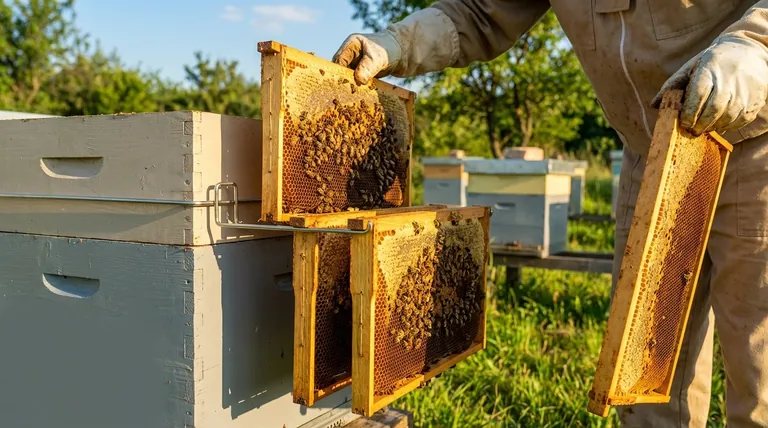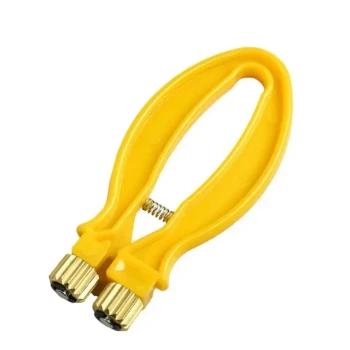In short, the primary advantage of a frame rest for the bees is a significant reduction in stress and physical harm during hive inspections. This simple tool provides a secure, clean place to hang frames outside the hive, which prevents them from being dropped, keeps the delicate comb intact, and minimizes overall disturbance to the colony.
A frame rest is not just a convenience for the beekeeper; it is a critical tool for minimizing colony stress. By creating a stable and clean environment during an inspection, you directly contribute to the hive's health, stability, and productivity.

The Core Principle: Reducing Inspection Stress
Every time you open a hive, you disrupt a highly organized and sensitive environment. The goal of a responsible beekeeper is to conduct necessary inspections as efficiently and calmly as possible. A frame rest is fundamental to achieving this.
Preventing Physical Trauma
Without a dedicated rest, frames are often precariously leaned against the hive box. This is unstable.
A sudden slip or gust of wind can cause frames to fall, crushing bees between them or on the ground. This also risks damaging the queen if she is on one of the outer frames.
A frame rest holds frames securely, virtually eliminating the risk of them falling and causing this kind of direct, physical harm to the bees.
Maintaining Hive Integrity
The honeycomb is the skeleton, pantry, and nursery of the colony. It is delicate and easily damaged.
When frames are mishandled or dropped, the comb can break. This results in spilled honey, lost pollen, and destroyed brood (eggs, larvae, and pupae).
The bees must then expend significant energy and resources to repair this damage, diverting them from other vital tasks like foraging and raising new bees. A frame rest protects this critical hive structure.
Upholding Hive Hygiene
Bees meticulously maintain the interior of their hive, coating surfaces with a substance called propolis. This "propolis envelope" has antimicrobial properties and helps defend the colony against pathogens.
Placing frames on the ground introduces dirt, debris, and potential diseases directly into the hive when you return them.
By keeping frames off the ground, a frame rest helps you respect and preserve the clean environment the bees have worked so hard to create, reducing the risk of contamination.
Why This Simple Tool is Often Overlooked
While the benefits are clear, some beekeepers work without a frame rest, often to their and their bees' detriment. Understanding the consequences of not using one highlights its true value.
The "It's Just One More Thing" Mentality
Beekeeping involves a fair amount of equipment, and it can be tempting to skip what seems like a minor accessory.
However, the small effort of bringing a frame rest to the apiary pays significant dividends in colony health and makes the entire inspection process smoother and less stressful for both you and the bees.
The Hidden Costs of Not Using a Rest
Working without a frame rest often leads to agitated bees. When frames are handled clumsily or dropped, the bees become defensive, making the rest of the inspection more difficult.
This cycle of disruption and agitation can leave a colony stressed for hours or even days after you close the hive. Repeatedly stressful inspections can contribute to a weaker, less productive colony over time.
Making the Right Choice for Your Goal
Adopting a frame rest is a simple change in practice that aligns your work with the natural needs of the honey bee colony.
- If your primary focus is calmer, safer inspections: A frame rest provides a stable, organized workspace, allowing you to be more deliberate and less disruptive.
- If your primary focus is maximizing hive health: Using a frame rest directly protects bees from injury, preserves their food stores and brood, and upholds the hygienic barrier of the hive.
Ultimately, thoughtful practices and simple tools are what separate good beekeeping from great beekeeping.
Summary Table:
| Key Advantage | Direct Benefit for Bees |
|---|---|
| Prevents Physical Trauma | Eliminates the risk of frames falling and crushing bees or the queen. |
| Maintains Hive Integrity | Protects delicate honeycomb from damage, preserving brood and food stores. |
| Upholds Hive Hygiene | Keeps frames clean, preventing contamination from dirt and pathogens. |
Equip your apiary for success with HONESTBEE.
As a trusted supplier for commercial apiaries and beekeeping equipment distributors, we understand that the health of your bees is the foundation of your productivity. Simple, high-quality tools like a frame rest are essential for professional beekeeping operations focused on maximizing colony health and honey yields.
Let HONESTBEE provide the durable, reliable equipment your business needs to conduct efficient, low-stress inspections. Our wholesale-focused operations are designed to support your scale and goals.
Contact our team today to discuss your equipment needs and see how we can help your operation thrive.
Visual Guide

Related Products
- Heavy-Duty Stainless Steel Frame Perch
- Heavy-Duty Stainless Steel Clip-On Frame Perch
- Heavy-Duty T-Style Frame Perch
- Professional 3-Bar Frame Grip with Integrated Hive Tool
- JZBZ Langstroth Queen Rearing Frame for Beekeeping
People Also Ask
- What factors should be considered when choosing hive frame sizes? Choose the Right Box for Your Strength & Goals
- How many frames can the beehive frame perch hold? Organize Your Hive Inspections with Ease
- How many frames can a frame perch hold? Optimize Your Hive Inspections with the Right Tool
- How does the beehive frame perch improve hive inspections? Boost Efficiency & Protect Your Hive
- What is the purpose of the beehive frame perch? Improve Hive Inspection Safety & Efficiency



















